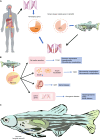Zebrafish as a preclinical model for diabetes mellitus and its complications: From monogenic to gestational diabetes and beyond
- PMID: 40487612
- PMCID: PMC12142174
- DOI: 10.4239/wjd.v16.i5.100574
Zebrafish as a preclinical model for diabetes mellitus and its complications: From monogenic to gestational diabetes and beyond
Abstract
With diabetes currently affecting 537 million people globally, innovative research approaches are urgently required. Zebrafish (Danio rerio) has emerged as a pivotal model organism in diabetes research, particularly valuable for developmental biology studies and preclinical therapeutic validation. Its rapid life cycle, optical transparency, and genetic tractability collectively enable efficient longitudinal observation of pathological progression and pharmacological responses. Utilizing zebrafish models, researchers have elucidated fundamental mechanisms governing islet development, β-cell dysfunction, and metabolic dysregulation. These experimental systems have significantly advanced our understanding of various diabetes subtypes, including type 1, type 2, gestational, and monogenic forms, while also facilitating mechanistic studies of diabetic complications such as retinopathy and nephropathy. Recent model refinements, particularly in simulating monogenic disorders and pregnancy-associated metabolic changes, promise to deepen our comprehension of disease pathophysiology and therapeutic interventions. Nevertheless, a persistent limitation lies in their incomplete recapitulation of human-specific physiological complexity and multi-organ metabolic interactions, factors that may influence translational applicability. Despite these constraints, zebrafish-based research continues to provide an indispensable platform for diabetes investigation, holding significant promise for alleviating the escalating global burden of this metabolic disorder.
Keywords: Diabetes mellitus; Gestational diabetes; Monogenic diabetes; Preclinical model; Zebrafish.
©The Author(s) 2025. Published by Baishideng Publishing Group Inc. All rights reserved.
Conflict of interest statement
Conflict-of-interest statement: Both authors report no relevant conflicts of interest for this article.
Figures




References
-
- Saeedi P, Petersohn I, Salpea P, Malanda B, Karuranga S, Unwin N, Colagiuri S, Guariguata L, Motala AA, Ogurtsova K, Shaw JE, Bright D, Williams R IDF Diabetes Atlas Committee. Global and regional diabetes prevalence estimates for 2019 and projections for 2030 and 2045: Results from the International Diabetes Federation Diabetes Atlas, 9(th) edition. Diabetes Res Clin Pract. 2019;157:107843. - PubMed
-
- Sun H, Saeedi P, Karuranga S, Pinkepank M, Ogurtsova K, Duncan BB, Stein C, Basit A, Chan JCN, Mbanya JC, Pavkov ME, Ramachandaran A, Wild SH, James S, Herman WH, Zhang P, Bommer C, Kuo S, Boyko EJ, Magliano DJ. IDF Diabetes Atlas: Global, regional and country-level diabetes prevalence estimates for 2021 and projections for 2045. Diabetes Res Clin Pract. 2022;183:109119. - PMC - PubMed
-
- Magliano DJ, Boyko EJ IDF Diabetes Atlas 10th edition scientific committee. IDF Diabetes Atlas [Internet]. 10th ed. Brussels: International Diabetes Federation, 2021. - PubMed
-
- Tao Z, Shi A, Zhao J. Epidemiological Perspectives of Diabetes. Cell Biochem Biophys. 2015;73:181–185. - PubMed
-
- Cloete L. Diabetes mellitus: an overview of the types, symptoms, complications and management. Nurs Stand. 2022;37:61–66. - PubMed
Publication types
LinkOut - more resources
Full Text Sources

